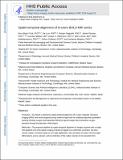Spatiotemporal alignment of in utero BOLD-MRI series: Spatiotemporal Alignment of MRI series
Author(s)
Turk, Esra Abaci; Luo, Jie; Gagoski, Borjan; Pascau, Javier; Bibbo, Carolina; Robinson, Julian N; Grant, P Ellen; Adalsteinsson, Elfar; Golland, Polina; Malpica, Norberto; ... Show more Show less
DownloadAccepted version (2.562Mb)
Terms of use
Metadata
Show full item recordAbstract
© 2017 International Society for Magnetic Resonance in Medicine Purpose: To present a method for spatiotemporal alignment of in-utero magnetic resonance imaging (MRI) time series acquired during maternal hyperoxia for enabling improved quantitative tracking of blood oxygen level-dependent (BOLD) signal changes that characterize oxygen transport through the placenta to fetal organs. Materials and Methods: The proposed pipeline for spatiotemporal alignment of images acquired with a single-shot gradient echo echo-planar imaging includes 1) signal nonuniformity correction, 2) intravolume motion correction based on nonrigid registration, 3) correction of motion and nonrigid deformations across volumes, and 4) detection of the outlier volumes to be discarded from subsequent analysis. BOLD MRI time series collected from 10 pregnant women during 3T scans were analyzed using this pipeline. To assess pipeline performance, signal fluctuations between consecutive timepoints were examined. In addition, volume overlap and distance between manual region of interest (ROI) delineations in a subset of frames and the delineations obtained through propagation of the ROIs from the reference frame were used to quantify alignment accuracy. A previously demonstrated rigid registration approach was used for comparison. Results: The proposed pipeline improved anatomical alignment of placenta and fetal organs over the state-of-the-art rigid motion correction methods. In particular, unexpected temporal signal fluctuations during the first normoxia period were significantly decreased (P < 0.01) and volume overlap and distance between region boundaries measures were significantly improved (P < 0.01). Conclusion: The proposed approach to align MRI time series enables more accurate quantitative studies of placental function by improving spatiotemporal alignment across placenta and fetal organs. Level of Evidence: 1. Technical Efficacy: Stage 1. J. MAGN. RESON. IMAGING 2017;46:403–412.
Date issued
2017Department
Madrid-MIT M+Vision Consortium; Massachusetts Institute of Technology. Department of Electrical Engineering and Computer Science; Massachusetts Institute of Technology. Computer Science and Artificial Intelligence LaboratoryJournal
Journal of Magnetic Resonance Imaging
Publisher
Wiley
Citation
Turk, E. A., et al. "Spatiotemporal Alignment of in Utero Bold-Mri Series." J Magn Reson Imaging (2017).
Version: Author's final manuscript